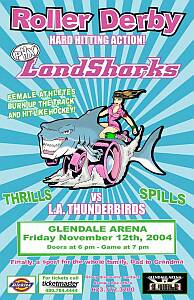
 Typical. Wait ages for one roller-derby league, then two start up almost after each other. Back in June, we wrote about AZ Roller Derby, but a schism arose almost immediately, disenchanted skaters breaking off into the Renegade Rollergirls. A third group also peeled off in another direction. The reasons are not relevant: here, we don’t take sides, especially if it increases our opportunities for femayhem. Regardless, almost-certainly-not-coincidence, two of these three had their first interstate bouts within a week of each other. [While some Renegade Rollergirls took part in the second of these, it wasn’t run by them – their debut is currently scheduled for January] Here’s a comparison shoppers’ guide to events…
Typical. Wait ages for one roller-derby league, then two start up almost after each other. Back in June, we wrote about AZ Roller Derby, but a schism arose almost immediately, disenchanted skaters breaking off into the Renegade Rollergirls. A third group also peeled off in another direction. The reasons are not relevant: here, we don’t take sides, especially if it increases our opportunities for femayhem. Regardless, almost-certainly-not-coincidence, two of these three had their first interstate bouts within a week of each other. [While some Renegade Rollergirls took part in the second of these, it wasn’t run by them – their debut is currently scheduled for January] Here’s a comparison shoppers’ guide to events…
November 6th, Surfside Skateland, Tempe. The original federation got their skates on first, sending out an all-star team selected from the home players, called the Tent City Terrors – the name is a tongue-in-cheek tribute to local sheriff Joe Arpaio, who is nationally known…either for being tough on criminals or an incompetent publicity-whore who relies on gimmicks, depending on your viewpoint. Their opponents were the Texas Rollergirls, a group who split off last year from BGGW/TXRD; they came to take on the Phoenix ladies on Saturday, then were going down to Tucson for a match again a southern Arizona all-star team on Sunday.
The venue for the first bout was Surfside Skateland, a place with both benefits and limitations: you can get very close to the action, but it’s not designed for spectator sports, and the only seating was three rows of folding chairs at each end of the rink. If you didn’t get there early, audience members either have to stand or sit on the floor down in front. And if you opt for the latter, you might end up with a roller-derby girl flying into your lap – I leave it to the reader to decide whether this is good! On the definite-plus side, concessions are cheap: a bottle of water is only a buck, where they were also offering $2 beers. However, I didn’t bother, since with it being an all-ages show and a small venue, you can’t take your beer back to your seat, but have to drink it in the designated area. Of the two MC’s providing colour commentary and announcements, one seemed to think that the louder he bellowed into the mic, the better it was: he was wrong. We were far from the only people cramming fingers into our ears and wishing for a high-velocity rifle.
This match consisted of three 20-minute periods, with bands providing entertainment during the intermision. I’m aware of AZRD’s origins on azpunk.com, and roller derby’s close ties to the music scene (which appear almost compulsory nationwide). But it still feels like a clumsy mix, and few people seemed the slightest bit concerned when a power outage brought the second set to a premature close. There was also a half-time raffle for sponsors’ goody-bags – the same guy won about three, making for a good investment!
As for the game itself…we got our butts kicked. The visiting girls were simply faster and tougher, as well as more experienced (roller derby in Texas dates back to TXRD’s creation in 2001), and this disparity was painfully clear from about five minutes in. The first brawl saw AZ captain Ivanna Spankin left looking for the number of the truck that just hit her, and by the end of twenty minutes, Arizona was behind 42-18. This huge lead rendered the rest of the contest almost irrelevant: the two other periods were closer, but by the end, Texas had racked up a three-figure point tally too large for the scoreboard to handle, winning 102-60.
This was a little embarrassing, especially since cameras from the Game Show Network were there to capture the event. However, it’s about par for Phoenix: last season, our baseball, hockey, NFL and basketball teams all ended up near-last in their leagues, so we’re getting pretty used to defeat here. :-( [The Texas team then went down to Tucson, and did a number on them too, 110-70] We were left hoping for a better showing two weeks down the line, when our local heroines were flying out to Austin, to take on the Lone Star ladies on their home turf, but still had an enjoyable evening.
November 12th, Glendale Arena. The following Friday, the Phoenix Landsharks took on the LA Thunderbirds at Glendale Arena. Originally built as a home for the Phoenix Coyotes ice-hockey team, this cost $180m and seats up to 18,000. However, with the current NHL lockout, there are suddenly a lot of blank dates to fill. Hence the unexpected presence of roller derby, with advance predictions of up to 5,000 in attendance – which I have to say, seemed more than a little optimistic.
We got tickets through a contact at the Coyotes (thanks, Marissa!) for $15; if we’d gone through Ticketbastard, and paid the “building facility charge”, “convenience charges” and “order processing fee”, a single ticket would have been $26.40. We battled our way across town, through both rush-hour traffic and torrential rain, and saw the arena rising up in the middle of nowhere – while it’ll eventually be the centre of a whole complex, for the moment, it’s a long drive if you want a restaurant. As is, you pay stadium prices ($3.75 for a bottle of water), but can take beer to your seat.
It’s the first time we’ve been there, since we’re not hockey fans – actually, we used to go to Phoenix Mustangs’ games, we’re just not NHL ticket price fans. But I digress. It’s an impressive venue, with good sightlines and plenty of space: we settled in, a few rows from the front with no trouble [the crowd was nearer 500 than 5,000] The first difference from AZRD was obvious: a banked track. As an engineering feat, it certainly beat two strands of ropelights duct-taped to the floor, though I have to say, it looked a little dangerous. The outside barrier was a rope running around pillars (see photo), and that was all there was to prevent a skater flying off, and onto the unyielding concrete floor.
 As we waited, promo videos played on the scoreboard, an enormous device hung from the ceiling like a cannon on the Death Star. Bonus points for production values on these films, which explained the rules and introduced the players, as well as promos for their sponsors: Dickies, the Platinum Girlz promotional company, etc. We learned they were calling the venue ‘The Shark Tank’, which is a catchy name, and that the rules were basically the same; the only major difference was there’d be four periods, each of ten 90-second jams, rather than three twenty-minute periods. On the downside, there was no program, and merchandise was limited to one design of T-shirt. One wonders perhaps how quickly this event had been scheduled.
As we waited, promo videos played on the scoreboard, an enormous device hung from the ceiling like a cannon on the Death Star. Bonus points for production values on these films, which explained the rules and introduced the players, as well as promos for their sponsors: Dickies, the Platinum Girlz promotional company, etc. We learned they were calling the venue ‘The Shark Tank’, which is a catchy name, and that the rules were basically the same; the only major difference was there’d be four periods, each of ten 90-second jams, rather than three twenty-minute periods. On the downside, there was no program, and merchandise was limited to one design of T-shirt. One wonders perhaps how quickly this event had been scheduled.
Generally, though: so far, so good. The two teams came out, were introduced to the crowd (Phoenix were missing their captain, Anita Cocktail, with a torn rotator cuff), and battle commenced. Which is where things got weird. For from about two jams in, it was clear that something odd had happened. Any semblance of competitive edge vanished from the LA team quicker than air leaving a burst balloon. Arizona scored four points; then five; then four more. They won the first period 25-3, and the second by an almost equally wide margin; we also saw one thunderous body check which, save for the quick actions of one cameraman, would have propelled a Thunderbird head-first out of the track onto floor. The body language and apathy of the visitors clearly showed they were extremely pissed-off about something. But what?
During the halftime interval, we were entertained by cheerleaders and a display of swordfighting. The latter was kinda lame, but the cheerleading was acrobatic, though for some reason, as they hurled each other fifteen feet in the air above the bare concrete, all I could think of was the sound of necks snapping like twigs. All told, at least it wasn’t mediocre bands, so we’ll take it. The home team came out, and we waited for the LA Thunderbirds to return. And we waited. And waited. Finally, after much to-ing and fro-ing, their captain came out and launched into a tirade complaining about the track being waxed, and unacceptable. This didn’t seem to make much sense – the home team had no obvious problems skating – and I wondered if this was all some carefully worked angle to try and generate some heat. Except, if it was, it made little sense, and wasn’t very well executed.

Finally, after about a 40 minute delay, mutterings from LA about injuries, and amid threats of the whole team being suspended from play for a year, enough Thunderbirds came back to skate a few lacklustre jams, to give the bout some semblance of closure (the final score was round about 66-6). I’ve not had any official explanation, but I subsequently heard that a lot of the LA team were veterans of the old-school of roller derby – we did note they lacked the florid skating names of the Phoenix team – where the action was more choreographed, and were expecting something similar here. When they didn’t get it, they were peeved; if you imagine two combatants, one anticipating a pillow fight, the other a full-contact karate bout, you can get an idea of the situation.
It was rather disappointing – and hence the advantage is clearly with the AZRD, as far as the Phoenix roller derby scene goes. Though I don’t blame the Landsharks themselves for the chaotic events; they handled themselves with dignity and can clearly skate. If the above story is indeed the case, the fault is partly with the Thunderbirds (when AZRD were getting their asses kicked, they tried harder), and partly whoever it was that set the bout up, without ensuring the two sides were playing the same game. I do think, however, that starting at an 18,000 seat arena was a mistake. Selling out a 300-seat venue would have been more effective at generating buzz, and Saturday night’s events may actually have set back roller derby in Phoenix more than they helped.
The above piece probably generated more feedback and interest than any article in gwg.org history. :-) We subsequently received an email from Celeste Cooper (a.k.a. Alotta Trouble, captain of the Landsharks), giving their side of the story, while the T-Birds issued a press release. Here are both. Most bizarrely of all, at the time of writing this footnote – November 22nd – the T-Birds website says they have accepted a Landsharks offer of a rematch in January. This again raises the possibility the whole thing was artificially fabricated to generate ‘heat’ and foment a rivalry. I’m still not convinced this is the case, however – if so, it was one of the most badly-bungled angles I’ve seen in all my years of watching ‘sports entertainment’. 28th November: Alotta Trouble denies any such rematch is scheduled, though the T-Birds website still says otherwise. At this point, I throw up my hands in bemusement, and move on…
Oh, and two weeks later, Texas completed their sweep over Arizona in the Austin matches, beating Tucson 79-38, and Phoenix 72-51.





 Roller Derby is quintessentially American; like the drive-in, it’s rarely seen outside the US. And also like the drive-in, it began in the 1930’s, when Chicago’s Leo Seltzer combined two crazes: roller-skating and the dance marathon. His contest for couples, over 57,000 laps (the distance between Los Angeles and New York). drew 20,000 spectators in its opening week. The power of the concept was proven, but it took a few years for it to evolve into a contact sport – Damon Runyon, author of Guys and Dolls, helped Seltzer incorporate these elements, and also the change in aim from distance to the scoring of points.
Roller Derby is quintessentially American; like the drive-in, it’s rarely seen outside the US. And also like the drive-in, it began in the 1930’s, when Chicago’s Leo Seltzer combined two crazes: roller-skating and the dance marathon. His contest for couples, over 57,000 laps (the distance between Los Angeles and New York). drew 20,000 spectators in its opening week. The power of the concept was proven, but it took a few years for it to evolve into a contact sport – Damon Runyon, author of Guys and Dolls, helped Seltzer incorporate these elements, and also the change in aim from distance to the scoring of points.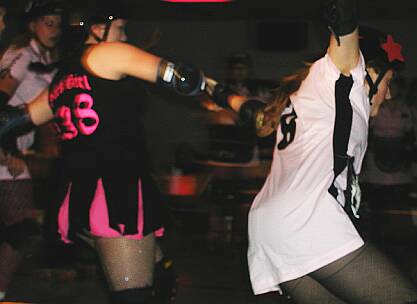 The golden era of the sport began in the 1950’s, when television helped roller derby become popular in almost every state. However, the 1970’s saw it go into decline, and it has never recovered, despite attempts to revive it. Most recently, there was RollerJam, an exercise closer to professional wrestling and co-funded by TNN, that stumbled along despite the assistance of Leo Seltzer’s son, Jerry, and finally went under in June 2000.
The golden era of the sport began in the 1950’s, when television helped roller derby become popular in almost every state. However, the 1970’s saw it go into decline, and it has never recovered, despite attempts to revive it. Most recently, there was RollerJam, an exercise closer to professional wrestling and co-funded by TNN, that stumbled along despite the assistance of Leo Seltzer’s son, Jerry, and finally went under in June 2000.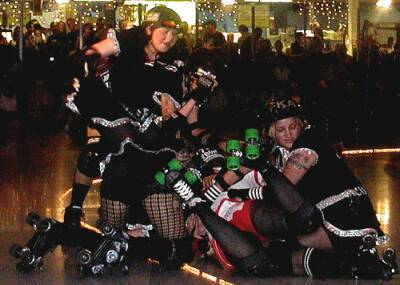 After getting through, the jammers then lap the pack, and again approach it from behind. Only this time, they score one point for every opponent they pass. Which is where the fun starts, since the opposition is trying to block them, and their team-mates are trying to block the blockers, while also stopping the opposition’s jammer from passing them and scoring. A match consists of two periods, each lasting twenty minutes; most points wins.
After getting through, the jammers then lap the pack, and again approach it from behind. Only this time, they score one point for every opponent they pass. Which is where the fun starts, since the opposition is trying to block them, and their team-mates are trying to block the blockers, while also stopping the opposition’s jammer from passing them and scoring. A match consists of two periods, each lasting twenty minutes; most points wins. I was a little surprised to see a flat track, it was simply marked out on the surface of the rink with rope lights; the teams are working towards banking, and have weekly fundraisers at Ziggy’s in Tempe – including a spanking booth! For the moment, they make do and, regardless, the pace was fast and furious; while the skating ability on view was variable, these women are athletes, make no mistake about it. The best jammers, such as Sara Veza and Go Go Liz, slid through the pack like a knife through butter. Even rookies like ourselves could see the skill required, while perhaps not appreciating the subtle refinements of the sport. [Alright, “subtle” is stretching it. There’s a whole page on their website, with photos of the injuries players have received…]
I was a little surprised to see a flat track, it was simply marked out on the surface of the rink with rope lights; the teams are working towards banking, and have weekly fundraisers at Ziggy’s in Tempe – including a spanking booth! For the moment, they make do and, regardless, the pace was fast and furious; while the skating ability on view was variable, these women are athletes, make no mistake about it. The best jammers, such as Sara Veza and Go Go Liz, slid through the pack like a knife through butter. Even rookies like ourselves could see the skill required, while perhaps not appreciating the subtle refinements of the sport. [Alright, “subtle” is stretching it. There’s a whole page on their website, with photos of the injuries players have received…]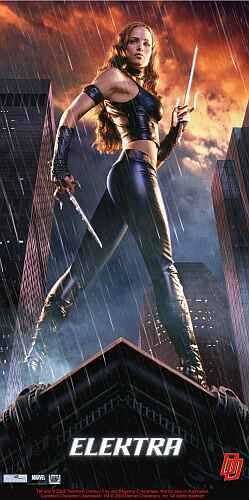 While 2003 has been touted as the Year of the Comic-book Movie, those centred around heroines have been notable by their absence. Sure, X-Men 2, League of Extraordinary Gentlemen and Daredevil have then in supporting roles, but going by the example of the last-named, anyone expecting much is likely to be sorely disappointed. Elektra, one of the toughest, deepest, most twisted characters in comics history – at least in the Bill Sienkiewicz/Frank Miller incarnation – was reduced to little more than a simplistic sidebar of little relevance. Credit to Jennifer Garner for doing what she could, but it’s safe to say that we’re not awaiting the touted Elektra spinoff with anything more than a “that’s nice” level of anticipation.
While 2003 has been touted as the Year of the Comic-book Movie, those centred around heroines have been notable by their absence. Sure, X-Men 2, League of Extraordinary Gentlemen and Daredevil have then in supporting roles, but going by the example of the last-named, anyone expecting much is likely to be sorely disappointed. Elektra, one of the toughest, deepest, most twisted characters in comics history – at least in the Bill Sienkiewicz/Frank Miller incarnation – was reduced to little more than a simplistic sidebar of little relevance. Credit to Jennifer Garner for doing what she could, but it’s safe to say that we’re not awaiting the touted Elektra spinoff with anything more than a “that’s nice” level of anticipation.
 I usually start watching this in a sense of disbelief, since it’s certainly not the most immediately convincing of movies. However, there’s a point near the middle which has in quick succession an amazing action sequence and two revelations, one touching, one tragic, and I realise that I am, yet again, utterly buying into the characters, storyline and setting. Disbelief simply ceases to be an option, and by the end, I know why this is among my all-time favourites, not just in the action heroine genre, but among all cinema.
I usually start watching this in a sense of disbelief, since it’s certainly not the most immediately convincing of movies. However, there’s a point near the middle which has in quick succession an amazing action sequence and two revelations, one touching, one tragic, and I realise that I am, yet again, utterly buying into the characters, storyline and setting. Disbelief simply ceases to be an option, and by the end, I know why this is among my all-time favourites, not just in the action heroine genre, but among all cinema.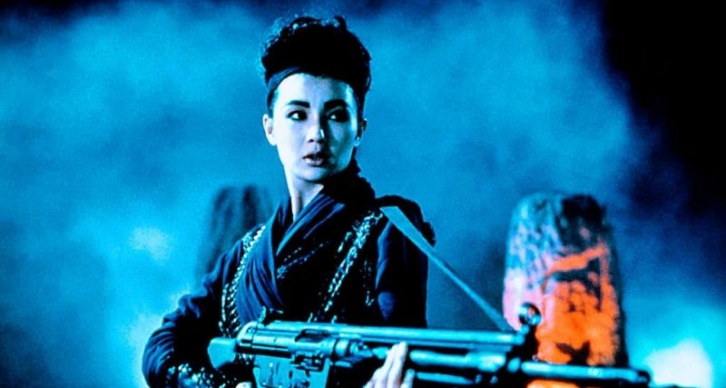

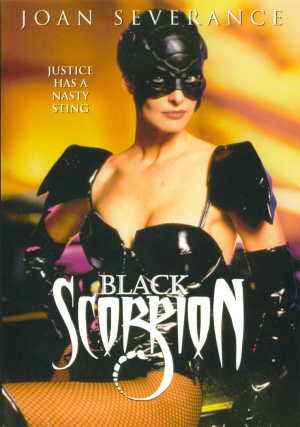 Roger Corman is a man without shame – and that’s in no way intended as an insult. He simply utilises any resource to the best of its ability, as is shown by the
Roger Corman is a man without shame – and that’s in no way intended as an insult. He simply utilises any resource to the best of its ability, as is shown by the 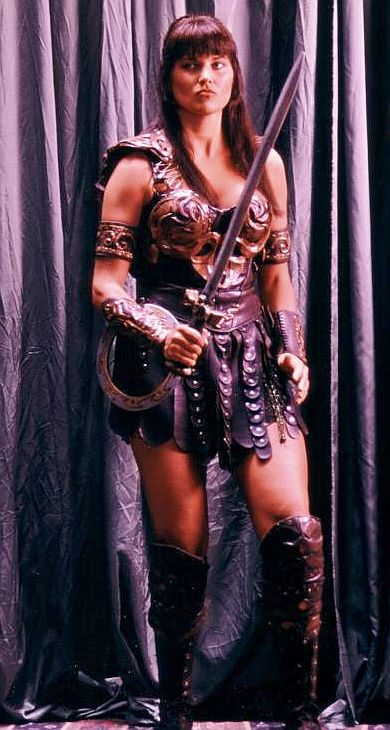
 There was enormous, often ferocious debate among fandom over the nature of Xena and Gabrielle’s relationship, some asserting they were a lesbian couple. While both showed plenty of evidence of heterosexuality, there was a lot of content open to interpretation – much of it absolutely deliberate, and known as “subtext” in Xena fandom. I never found it convincing. My issue with it was not one of sexuality, simply compatibility: Xena and Gabrielle were absolute opposites, in background, upbringing, personality and approach. They just didn’t “fit” each other, from what I could see, and there was no chemistry visible. Xena and Hercules: I could see that. Xena and the Queen of the Amazons: no problem there either. But Xena and Gabrielle? Sorry. Not buying this. It also played into the stereotype that any strong woman
There was enormous, often ferocious debate among fandom over the nature of Xena and Gabrielle’s relationship, some asserting they were a lesbian couple. While both showed plenty of evidence of heterosexuality, there was a lot of content open to interpretation – much of it absolutely deliberate, and known as “subtext” in Xena fandom. I never found it convincing. My issue with it was not one of sexuality, simply compatibility: Xena and Gabrielle were absolute opposites, in background, upbringing, personality and approach. They just didn’t “fit” each other, from what I could see, and there was no chemistry visible. Xena and Hercules: I could see that. Xena and the Queen of the Amazons: no problem there either. But Xena and Gabrielle? Sorry. Not buying this. It also played into the stereotype that any strong woman  It’s assumed viewers are at least somewhat familiar with Xena’s background, as she is first seen burying her armour in an effort to bury her past. Of course, this is about as successful as it usually is in fiction, and it’s not long before she’s saving villagers, including Gabrielle, from slavery. That includes an aerial battle atop platforms, which is the first sign of the show’s strong influence from Hong Kong action films; it was using wirework, in a way that predated its popular arrival in Hollywood. Similarly, the stunning New Zealand locations foreshadow Lord of the Rings, to the extent that I kept expecting to see hobbits gamboling along in Xena’s wake.
It’s assumed viewers are at least somewhat familiar with Xena’s background, as she is first seen burying her armour in an effort to bury her past. Of course, this is about as successful as it usually is in fiction, and it’s not long before she’s saving villagers, including Gabrielle, from slavery. That includes an aerial battle atop platforms, which is the first sign of the show’s strong influence from Hong Kong action films; it was using wirework, in a way that predated its popular arrival in Hollywood. Similarly, the stunning New Zealand locations foreshadow Lord of the Rings, to the extent that I kept expecting to see hobbits gamboling along in Xena’s wake. The defining moment of Xena’s sophomore season didn’t take place in any episode. In fact, it didn’t even take place in New Zealand, but thousands of miles away, During a rehearsal for an appearance on The Tonight show with Jay Leno, Lucy Lawless was thrown off a horse after it lost its footing, and broke her pelvis. It’s interesting to compare the reaction of the producers to what the Tapert/Raimi team did when the star of Spartacus, Andy Whitfield, was similarly a victim of severe misfortune, more than a decade later. There, they put the show entirely on hold and opted instead to film a prequel without him.
The defining moment of Xena’s sophomore season didn’t take place in any episode. In fact, it didn’t even take place in New Zealand, but thousands of miles away, During a rehearsal for an appearance on The Tonight show with Jay Leno, Lucy Lawless was thrown off a horse after it lost its footing, and broke her pelvis. It’s interesting to compare the reaction of the producers to what the Tapert/Raimi team did when the star of Spartacus, Andy Whitfield, was similarly a victim of severe misfortune, more than a decade later. There, they put the show entirely on hold and opted instead to film a prequel without him. In terms of style and approach, the show covers even more ground here than the first time, from absolutely froth to grim darkness. Xena even gets crucified by Julius Caesar in one episode [confusingly, the actor responsible also crops up later, playing Cupid, complete with fluffy wings…]. I’m sure I’m not the only one who found themselves whistling Always Look on the Bright Side of Life, during the scene shown above right. Another unwitting Python reference is the wretched Here She Comss, Miss Amphipolis, a dreadful tale of drag-queen empowerment, featuring perhaps the least convincing female impersonator since John Cleese put on a dress – as on the left, watch that Adam’s apple
In terms of style and approach, the show covers even more ground here than the first time, from absolutely froth to grim darkness. Xena even gets crucified by Julius Caesar in one episode [confusingly, the actor responsible also crops up later, playing Cupid, complete with fluffy wings…]. I’m sure I’m not the only one who found themselves whistling Always Look on the Bright Side of Life, during the scene shown above right. Another unwitting Python reference is the wretched Here She Comss, Miss Amphipolis, a dreadful tale of drag-queen empowerment, featuring perhaps the least convincing female impersonator since John Cleese put on a dress – as on the left, watch that Adam’s apple  I used to be a Xena fan; for the first couple of series, I was a die-hard, never missed an episode, bought the merchandise, went to the gatherings, etc. I loved (with one exception) the supporting cast – Joxer, Ares, Autolycus – and still reckon Callisto remains one of the great TV villainesses of all time.
I used to be a Xena fan; for the first couple of series, I was a die-hard, never missed an episode, bought the merchandise, went to the gatherings, etc. I loved (with one exception) the supporting cast – Joxer, Ares, Autolycus – and still reckon Callisto remains one of the great TV villainesses of all time.
 The 1980’s were the Golden Era for action heroines in Hong Kong cinema. Names like Cynthia Khan (a.k.a. Cynthia Yeoh), Michelle Khan, Yukari Oshima, Cynthia Rothrock and Moon Lee all came to prominence in the decade. Just sliding in before the bubble burst was Jade Leung, who came out of nowhere to win Best Newcomer at the Hong Kong Film Awards for her performance in 1991’s Black Cat. Jade was born in the then-British colony, November 23rd 1969, but spent four of her later teenage years in Switzerland, where she studied fashion and learned French. In 1990, she returned to Hong Kong and was one of 200+ actresses to audition for Steven Shin, director of Black Cat. She won out, despite her lack of experience, and underwent a rigorous training program to get in shape for the movie.
The 1980’s were the Golden Era for action heroines in Hong Kong cinema. Names like Cynthia Khan (a.k.a. Cynthia Yeoh), Michelle Khan, Yukari Oshima, Cynthia Rothrock and Moon Lee all came to prominence in the decade. Just sliding in before the bubble burst was Jade Leung, who came out of nowhere to win Best Newcomer at the Hong Kong Film Awards for her performance in 1991’s Black Cat. Jade was born in the then-British colony, November 23rd 1969, but spent four of her later teenage years in Switzerland, where she studied fashion and learned French. In 1990, she returned to Hong Kong and was one of 200+ actresses to audition for Steven Shin, director of Black Cat. She won out, despite her lack of experience, and underwent a rigorous training program to get in shape for the movie.
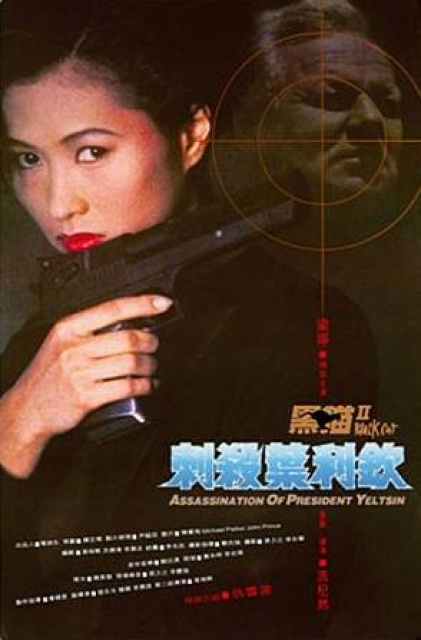



 This film is a 90-minute explanation of why Jade Leung’s star never took off. While some decisions Michelle Yeoh made might have been questionable, at least her films were rarely boring, and never down to the level of this piece of tedious dreck. It depicts the struggles of a class of policewomen (including Jade), to become part of the elite. The idea certainly has potential – the Inspector Wears Skirts series has a similar premise – but here, there is almost no character given to any of the girls; they all blur into each other, like a dozen GI Jane-wannabes.
This film is a 90-minute explanation of why Jade Leung’s star never took off. While some decisions Michelle Yeoh made might have been questionable, at least her films were rarely boring, and never down to the level of this piece of tedious dreck. It depicts the struggles of a class of policewomen (including Jade), to become part of the elite. The idea certainly has potential – the Inspector Wears Skirts series has a similar premise – but here, there is almost no character given to any of the girls; they all blur into each other, like a dozen GI Jane-wannabes.



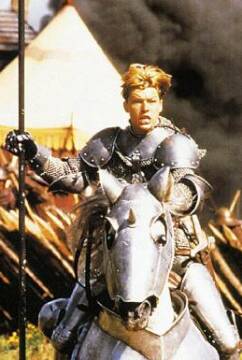
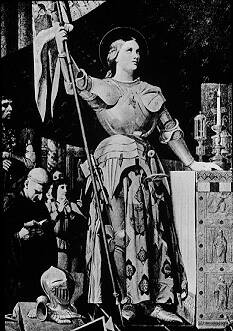 Born in the French province of Champagne in 1412, to a peasant farmer, Joan (or Jeanne – I’ll largely stick to the Anglicization) never learned to read or write, but was regarded by her contemporaries as a highly pious child. It was at the age of 13 that she first heard voices, but it took several years before they convinced her to leave home and help the French king, who was engaged in a battle to liberate the country from England. She presented herself to the local commander, who was skeptical at first, but was eventually convinced after Joan reported news of an English defeat before official confirmation arrived. Joan, clad in male attire to protect her modesty, travelled to see the king, and convinced him of the legitimacy of his claim to the throne, despite a faction of the court strongly opposing her influence. Her faith, simplicity and honesty won the day, and she acquired her sword, found buried behind an altar, in the exact spot she said it would be.
Born in the French province of Champagne in 1412, to a peasant farmer, Joan (or Jeanne – I’ll largely stick to the Anglicization) never learned to read or write, but was regarded by her contemporaries as a highly pious child. It was at the age of 13 that she first heard voices, but it took several years before they convinced her to leave home and help the French king, who was engaged in a battle to liberate the country from England. She presented herself to the local commander, who was skeptical at first, but was eventually convinced after Joan reported news of an English defeat before official confirmation arrived. Joan, clad in male attire to protect her modesty, travelled to see the king, and convinced him of the legitimacy of his claim to the throne, despite a faction of the court strongly opposing her influence. Her faith, simplicity and honesty won the day, and she acquired her sword, found buried behind an altar, in the exact spot she said it would be. This was nothing more than a show trial, despite the efforts of those in charge to find support: according to biographer Jules Michelet, one jurist said “that everything about the trial was wrong; that it failed to respect the proper forms; that the assessors were not free; that the sessions were held in secrecy; that the accused…could not be expected to argue with learned doctors” and finished by declaring that it “was a trial to impugn the honour of the prince whose cause this girl is supporting; you should frankly say so.” Perhaps wisely, the holder of these opinions opted to leave France immediately for the safety of Rome.
This was nothing more than a show trial, despite the efforts of those in charge to find support: according to biographer Jules Michelet, one jurist said “that everything about the trial was wrong; that it failed to respect the proper forms; that the assessors were not free; that the sessions were held in secrecy; that the accused…could not be expected to argue with learned doctors” and finished by declaring that it “was a trial to impugn the honour of the prince whose cause this girl is supporting; you should frankly say so.” Perhaps wisely, the holder of these opinions opted to leave France immediately for the safety of Rome.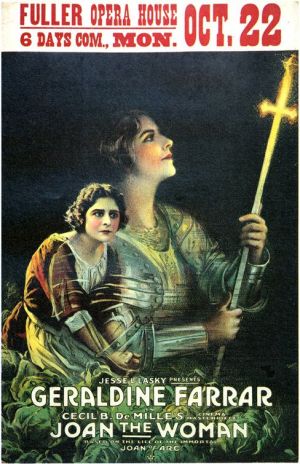 I don’t watch many silent films: it’s such an entirely different experience, obviously, much less driven by dialogue and more by gestures, leading to a style that can look extremely over-theatrical to the modern viewer. My efforts to enjoy the likes of Nosferatu, for example, have usually ended in my providing an accompaniment of snoring, to be honest. This was much better. Despite a running time of over two hours, this 1916 DeMille epic successfully held my interest, as it told the story of Joan of Arc. The framing device uses the then-contemporary World War I, and an English soldier (Reid) finds Joan’s sword in the trenches, the night before a dangerous mission [Interesting how the English are the enemy in the back-story, but the good guys “now” – at the time of release, America was still several months from entering the war, on the British side]. He then experiences a flashback vision, taking him to medieval France, where he is an English soldier saved by Joan (Farrar) in her milkmaid days. We follow her for the story you know, becoming the inspiration for the French army to defeat the English, before her capture, trial for heresy and – I trust I’m not spoiling this – burning at the stake.
I don’t watch many silent films: it’s such an entirely different experience, obviously, much less driven by dialogue and more by gestures, leading to a style that can look extremely over-theatrical to the modern viewer. My efforts to enjoy the likes of Nosferatu, for example, have usually ended in my providing an accompaniment of snoring, to be honest. This was much better. Despite a running time of over two hours, this 1916 DeMille epic successfully held my interest, as it told the story of Joan of Arc. The framing device uses the then-contemporary World War I, and an English soldier (Reid) finds Joan’s sword in the trenches, the night before a dangerous mission [Interesting how the English are the enemy in the back-story, but the good guys “now” – at the time of release, America was still several months from entering the war, on the British side]. He then experiences a flashback vision, taking him to medieval France, where he is an English soldier saved by Joan (Farrar) in her milkmaid days. We follow her for the story you know, becoming the inspiration for the French army to defeat the English, before her capture, trial for heresy and – I trust I’m not spoiling this – burning at the stake. This film’s origins as a stage play are painfully apparent, and you can also see why the distributor’s felt it needed to have 45 minutes cut out before it could be released, as frankly, it’s a bit of a bore. The battle to recapture Orleans is the only action of note here, even though that represented the start of the Maid’s campaign to restore France to its proper ruler (Ferrer), rather than the end. After that, this more or less skips forward to his coronation, then Joan’s capture, spending the rest of the movie – and there’s a lot of it – going through the trial, and the railroading of the heroine into, first throwing herself on the church’s mercy, then recanting her recantation and returning to wearing men’s clothes, thereby sealing her fate. There’s not much here which you won’t have seen before, if you’ve seen any of the other versions of the story, touching the usual bases from Joan’s revelations that she’s going to be the saviour of France, through her trip to see the Dauphin, and so on. It does downplay the “voices” aspect, especially early on, perhaps a wise move since it’s difficult to depict, without making her seem like a religious fruitcake.
This film’s origins as a stage play are painfully apparent, and you can also see why the distributor’s felt it needed to have 45 minutes cut out before it could be released, as frankly, it’s a bit of a bore. The battle to recapture Orleans is the only action of note here, even though that represented the start of the Maid’s campaign to restore France to its proper ruler (Ferrer), rather than the end. After that, this more or less skips forward to his coronation, then Joan’s capture, spending the rest of the movie – and there’s a lot of it – going through the trial, and the railroading of the heroine into, first throwing herself on the church’s mercy, then recanting her recantation and returning to wearing men’s clothes, thereby sealing her fate. There’s not much here which you won’t have seen before, if you’ve seen any of the other versions of the story, touching the usual bases from Joan’s revelations that she’s going to be the saviour of France, through her trip to see the Dauphin, and so on. It does downplay the “voices” aspect, especially early on, perhaps a wise move since it’s difficult to depict, without making her seem like a religious fruitcake.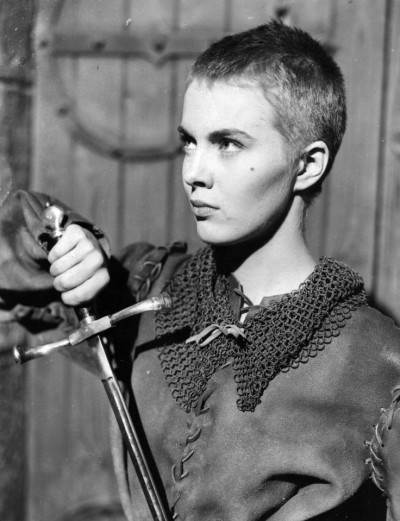

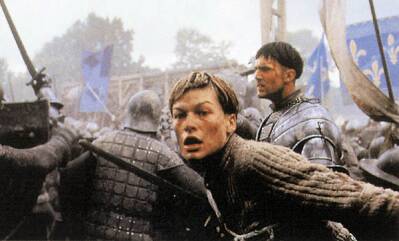 Joan’s capture, trial and execution are fairly close to the truth, though in reality, the King was less involved and more concerned for Joan than shown. It certainly is reasonable to suggest that a naive innocent such as Joan would have been used for political ends. Once she’d outlasted her usefulness – and with the king on the throne, she quickly became more a hindrance than a help – she would have needed to be disposed of. Must confess, I quite like the concept of Joan as a medieval version of Lee Harvey Oswald. Dustin Hoffman’s appearance as Joan’s conscience is another neat touch, and his sarcasm works well. Indeed, the film is one good performance from being excellent. The bad news is, it’s Jovovich who is the culprit (a messenger who deserves to be shot?), though Besson and co-writer Andrew Birkin perhaps warrant most of the criticism for twisting facts and characters in order to fit a predetermined goal. Their Joan is so far from the historical record, they’d have been better off placing their character in an entirely fictitious setting.
Joan’s capture, trial and execution are fairly close to the truth, though in reality, the King was less involved and more concerned for Joan than shown. It certainly is reasonable to suggest that a naive innocent such as Joan would have been used for political ends. Once she’d outlasted her usefulness – and with the king on the throne, she quickly became more a hindrance than a help – she would have needed to be disposed of. Must confess, I quite like the concept of Joan as a medieval version of Lee Harvey Oswald. Dustin Hoffman’s appearance as Joan’s conscience is another neat touch, and his sarcasm works well. Indeed, the film is one good performance from being excellent. The bad news is, it’s Jovovich who is the culprit (a messenger who deserves to be shot?), though Besson and co-writer Andrew Birkin perhaps warrant most of the criticism for twisting facts and characters in order to fit a predetermined goal. Their Joan is so far from the historical record, they’d have been better off placing their character in an entirely fictitious setting.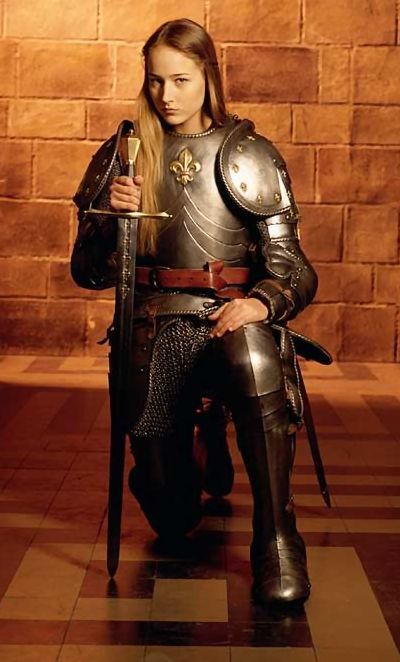
 However, the main difference between this and The Messenger is that Joan of Arc is convincing. Perhaps with the advantage of having extra time (the DVD of the miniseries runs 189 minutes), they make the effort to show her interacting with other characters, and Sobieski’s calm, complete assurance is a striking contrast to Jovovich. The viewer can see why people would believe her, and it naturally follows they will too – Sobieski’s Emmy nomination was entirely well-deserved. Despite playing fast and loose with the facts (another example: Joan’s brother was not killed in battle, but lived to see her trial verdict overturned), this strong central performance holds the film together and, with the aid of the other fine actors, makes it eminently watchable. It may not be historically accurate, but it does a fine job of explaining why her myth is still honoured in the third millennium, without coming down in one camp or the other regarding the source of her visions. There are few TV miniseries worth watching, and fewer still worth owning, but this one comes highly recommended.
However, the main difference between this and The Messenger is that Joan of Arc is convincing. Perhaps with the advantage of having extra time (the DVD of the miniseries runs 189 minutes), they make the effort to show her interacting with other characters, and Sobieski’s calm, complete assurance is a striking contrast to Jovovich. The viewer can see why people would believe her, and it naturally follows they will too – Sobieski’s Emmy nomination was entirely well-deserved. Despite playing fast and loose with the facts (another example: Joan’s brother was not killed in battle, but lived to see her trial verdict overturned), this strong central performance holds the film together and, with the aid of the other fine actors, makes it eminently watchable. It may not be historically accurate, but it does a fine job of explaining why her myth is still honoured in the third millennium, without coming down in one camp or the other regarding the source of her visions. There are few TV miniseries worth watching, and fewer still worth owning, but this one comes highly recommended. Romero is most – indeed, almost
Romero is most – indeed, almost  Romero’s problems are, as ever, plot and dialogue. Chris literally stumbles into a secret entrance, yet apparently played there as a child. Chris and Jill get one brief scene, are separated for 30 pages, then come perilously close to having a quickie between kills. Then there are speeches like, “They made you believe you were doing a good thing when it wasn’t good at all. It was evil! The kind of evil that resides in all of us. Makes us greedy, uncaring. The kind of evil that will wipe us out, in the end. Unless we stand up against it.”
Romero’s problems are, as ever, plot and dialogue. Chris literally stumbles into a secret entrance, yet apparently played there as a child. Chris and Jill get one brief scene, are separated for 30 pages, then come perilously close to having a quickie between kills. Then there are speeches like, “They made you believe you were doing a good thing when it wasn’t good at all. It was evil! The kind of evil that resides in all of us. Makes us greedy, uncaring. The kind of evil that will wipe us out, in the end. Unless we stand up against it.”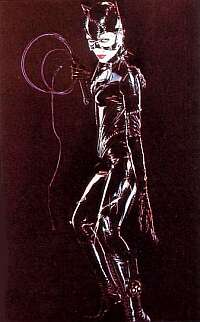 Daniel Waters’ career has been one of ups and downs. For every brilliantly-observed piece of satire, such as Heathers, there has been…well, Hudson Hawk. However, also on his resume is perhaps the best Dark Knight movie yet made, Batman Returns – though, let’s face it, with a supporting cast including Christopher Walken, Michelle Pfeiffer and Danny DeVito, a telephone directory would likely have made compelling viewing.
Daniel Waters’ career has been one of ups and downs. For every brilliantly-observed piece of satire, such as Heathers, there has been…well, Hudson Hawk. However, also on his resume is perhaps the best Dark Knight movie yet made, Batman Returns – though, let’s face it, with a supporting cast including Christopher Walken, Michelle Pfeiffer and Danny DeVito, a telephone directory would likely have made compelling viewing.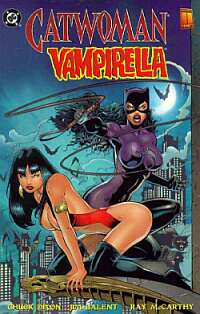 This is, very clearly, a parody of the superhero genre, playing with the conventions of secret identities, powers, merchandising and so on. The part of Spooky, one of the CoG members who is a woman masquerading as a male superhero, looks to have been written for Michelle Yeoh – one move is described as “a famous maneuver of renowned Hong Kong actress Michelle Khan — hint, hint” which puts Waters several years ahead of Hollywood in recognising her talents.
This is, very clearly, a parody of the superhero genre, playing with the conventions of secret identities, powers, merchandising and so on. The part of Spooky, one of the CoG members who is a woman masquerading as a male superhero, looks to have been written for Michelle Yeoh – one move is described as “a famous maneuver of renowned Hong Kong actress Michelle Khan — hint, hint” which puts Waters several years ahead of Hollywood in recognising her talents.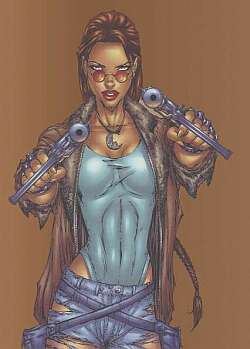 Few films had as twisted a path to the screen as Tomb Raider. [For a three-part history of some of the rumours since August 1997, see
Few films had as twisted a path to the screen as Tomb Raider. [For a three-part history of some of the rumours since August 1997, see  Once they enter the El Dorado complexes, the script reads like a description of levels from the game, with levers to pull, gaps to jump, tunnels to swim through, and keys to rooms located in other places. It’s hard to see how this could have been brought to the screen without feeling like you were watching someone playing the game. In addition, the trick used to locate an entrance is a painfully direct steal from the textbook of Dr. Jones – as is the massive, rolling boulder that forms one of the traps inside.
Once they enter the El Dorado complexes, the script reads like a description of levels from the game, with levers to pull, gaps to jump, tunnels to swim through, and keys to rooms located in other places. It’s hard to see how this could have been brought to the screen without feeling like you were watching someone playing the game. In addition, the trick used to locate an entrance is a painfully direct steal from the textbook of Dr. Jones – as is the massive, rolling boulder that forms one of the traps inside.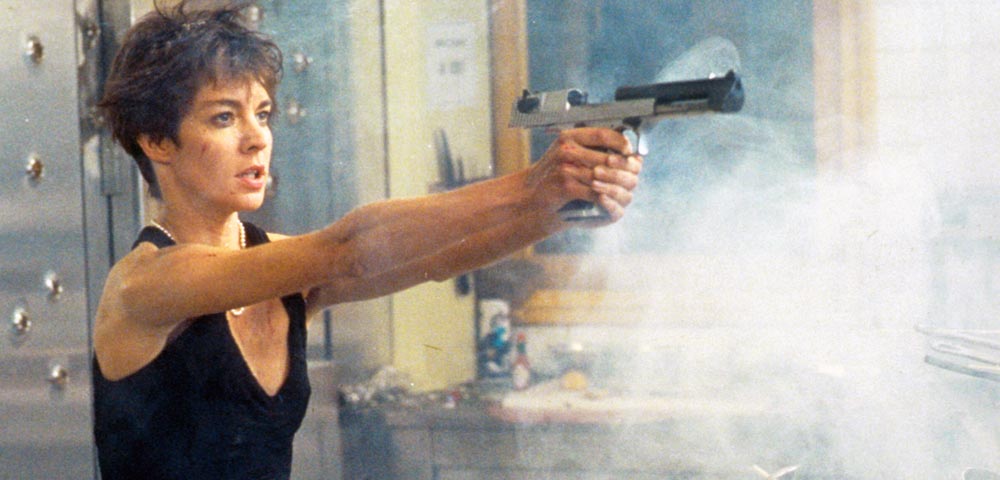
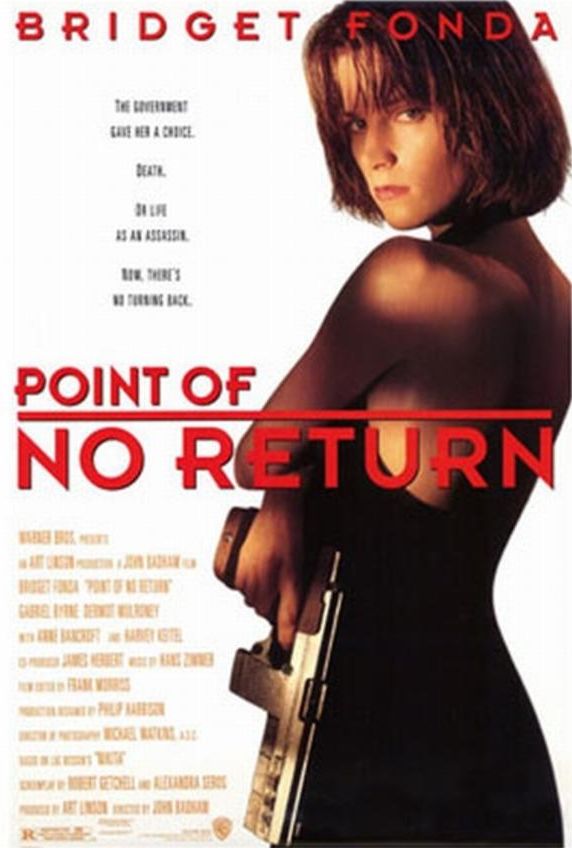
 ★★★
★★★ The other chance is that Section One, their version of Division, is not malicious – at least not in the same way. It’s certainly a heartless organization, which is utterly ruthless, and prepared to dispose of anyone who may interfere with their actions, but it’s more an awareness that when you’re dealing with terrorists, organized crime or other threats to the country and world, you can’t be unwilling to get your hands dirty. It leads to a significant bleaker overall tone, and is amazingly prophetic, given this was screened well before 9/11 led to this attitude become a necessary part of national security. Early on, it’s established that you can never trust Section heads Operation (Glazer) and Madeleine (Watson, who was also part of the remake, playing Senator Pierce – her given name there was also Madeleine), to the extent that their deceit becomes almost a cliché.
The other chance is that Section One, their version of Division, is not malicious – at least not in the same way. It’s certainly a heartless organization, which is utterly ruthless, and prepared to dispose of anyone who may interfere with their actions, but it’s more an awareness that when you’re dealing with terrorists, organized crime or other threats to the country and world, you can’t be unwilling to get your hands dirty. It leads to a significant bleaker overall tone, and is amazingly prophetic, given this was screened well before 9/11 led to this attitude become a necessary part of national security. Early on, it’s established that you can never trust Section heads Operation (Glazer) and Madeleine (Watson, who was also part of the remake, playing Senator Pierce – her given name there was also Madeleine), to the extent that their deceit becomes almost a cliché.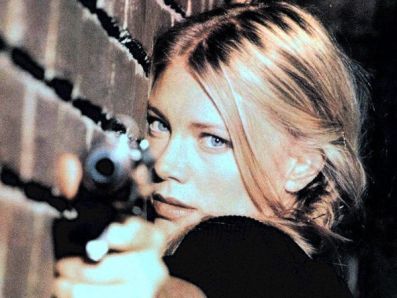 On the other hand, apart from the lack of action, the angle I liked least was the relationship between Nikita and her handler/fellow agent, Michael (Dupuis). I’ll come right out and say it: I hate ‘shippers, and storylines that pander to them are nothing more than an irritant to me, especially in shows which I watch for action, where they do little except interfere with the good stuff, in my humble opinion. [We’ve seen this in the new incarnation, where the show has disintegrated from one of the best shows on TV, into little more than Mr. and Mrs. Smith And Friends.] I’m definitely a “noromo”: If I wanted unresolved sexual tension and relationship nonsense, I’d watch daytime soap operas. Right from the first time Nikita and Michael meet, it’s doe-eyed heaven, even though there is obviously little or no honesty, trust and anything else on which a genuine relationship could ever be founded.
On the other hand, apart from the lack of action, the angle I liked least was the relationship between Nikita and her handler/fellow agent, Michael (Dupuis). I’ll come right out and say it: I hate ‘shippers, and storylines that pander to them are nothing more than an irritant to me, especially in shows which I watch for action, where they do little except interfere with the good stuff, in my humble opinion. [We’ve seen this in the new incarnation, where the show has disintegrated from one of the best shows on TV, into little more than Mr. and Mrs. Smith And Friends.] I’m definitely a “noromo”: If I wanted unresolved sexual tension and relationship nonsense, I’d watch daytime soap operas. Right from the first time Nikita and Michael meet, it’s doe-eyed heaven, even though there is obviously little or no honesty, trust and anything else on which a genuine relationship could ever be founded. ★★★★
★★★★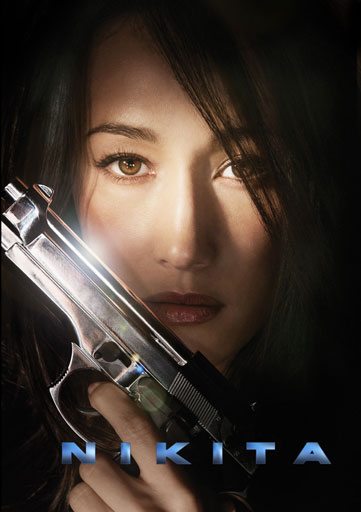 I was reassured by the casting of Maggie Q as the lead, who has a solid action pedigree, both in Hong Kong (Naked Weapon) and the West (Live Free or Die Hard and M-I:3). While its source material was clear, it took a different approach. Instead of telling Nikita’s story from the beginning, with her recruitment into a shadowy semi-official organization and training as an assassin, it starts later, after she has mutinied and left them. Now, she is working to bring down the organization known as Division, its leader, Percy (Berkeley), and his right-hand man, Michael (West), who trained Nikita before she went rogue. Her ‘secret weapon’ is Alex (Fonseca), a new recruit going through training, while acting as Nikita’s mole and feeding her information, allowing her to sabotage and obstruct Division’s missions.
I was reassured by the casting of Maggie Q as the lead, who has a solid action pedigree, both in Hong Kong (Naked Weapon) and the West (Live Free or Die Hard and M-I:3). While its source material was clear, it took a different approach. Instead of telling Nikita’s story from the beginning, with her recruitment into a shadowy semi-official organization and training as an assassin, it starts later, after she has mutinied and left them. Now, she is working to bring down the organization known as Division, its leader, Percy (Berkeley), and his right-hand man, Michael (West), who trained Nikita before she went rogue. Her ‘secret weapon’ is Alex (Fonseca), a new recruit going through training, while acting as Nikita’s mole and feeding her information, allowing her to sabotage and obstruct Division’s missions. They even crammed in nice nods to the original movie and its TV predecessor too, with a dive down a chute to escape, and a cameo from Alberta Watson, one of La Femme Nikita‘s actors, as part of the intelligence committee supposedly in charge of Division. By the time the dust has settled, Nikita was driving off into the sunset with a surprising ally, and Alex was also teamed up in a new way, setting things up nicely for the second series. Whether it was going to get one or not seemed in doubt for a while, as the rating did sag mid-season, dropping the show onto the ‘bubble’. However, it was announced in May that the CW would pick it up for another series, moving the show to Friday nights to play along with Supernatural.
They even crammed in nice nods to the original movie and its TV predecessor too, with a dive down a chute to escape, and a cameo from Alberta Watson, one of La Femme Nikita‘s actors, as part of the intelligence committee supposedly in charge of Division. By the time the dust has settled, Nikita was driving off into the sunset with a surprising ally, and Alex was also teamed up in a new way, setting things up nicely for the second series. Whether it was going to get one or not seemed in doubt for a while, as the rating did sag mid-season, dropping the show onto the ‘bubble’. However, it was announced in May that the CW would pick it up for another series, moving the show to Friday nights to play along with Supernatural.
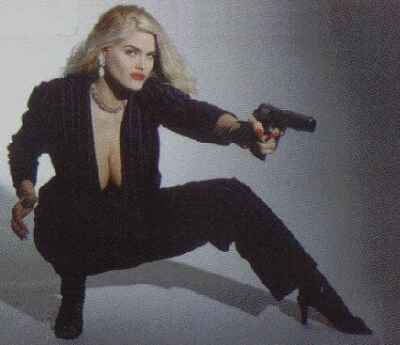 “Twin towers”
“Twin towers”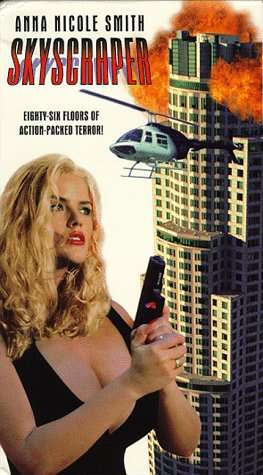 The obvious point of comparison for Smith would be Pamela Anderson, another Playboy playmate who moved into films of doubtful quality, but any such comparison would be unfair. To Anderson, that is, who given the right role, is not actually too bad. With Smith, you get the feeling she simply has no talent, and any character would be a stretch, let alone the Shakespeare-aware, ace helicopter pilot and crackshot she is supposed to portray in this shameless Die Hard clone.
The obvious point of comparison for Smith would be Pamela Anderson, another Playboy playmate who moved into films of doubtful quality, but any such comparison would be unfair. To Anderson, that is, who given the right role, is not actually too bad. With Smith, you get the feeling she simply has no talent, and any character would be a stretch, let alone the Shakespeare-aware, ace helicopter pilot and crackshot she is supposed to portray in this shameless Die Hard clone.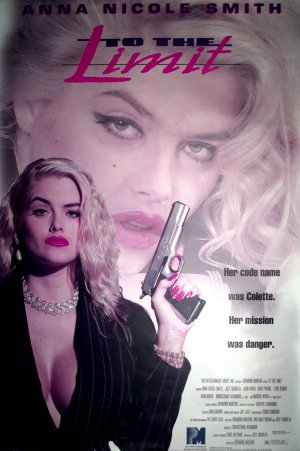
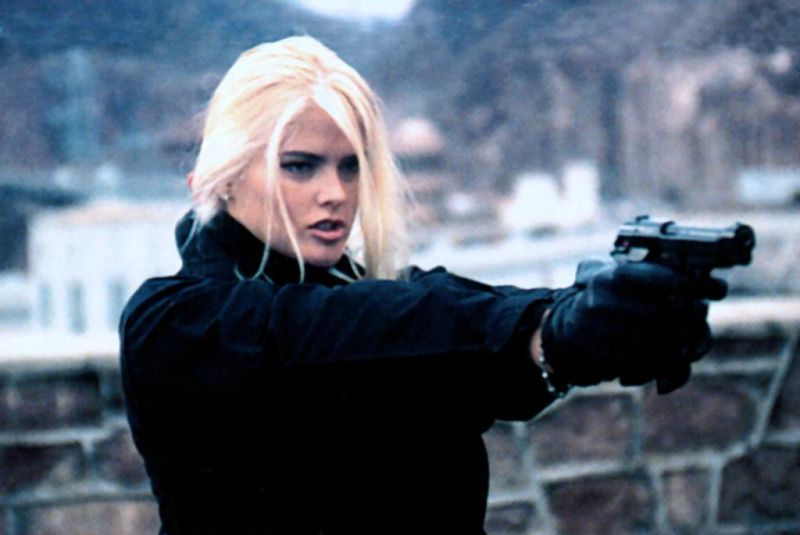
 Okay, her swansong won’t be up there with James Dean’s or Bruce Lee’s, but this does at least sense its own idiocy, rendering the movie somewhat bullet-proof, critically speaking. It’s supposed to be dumb, wildly implausible and hideously over-acted. So condemning it for these flaws is complaining because your hotdog tastes of meat. A trio of shape-shifting aliens land on Earth to protect it from the scum of the universe. Thanks to their first encounter with our culture coming in the shape of a porno mag, they opt for the form of attractive women. Two end up getting jobs as FX/stunt people in Hollywood – a sadly underexplored angle – while the third is…Anna Nicole Smith. Then their nemesis (Laurer, the actress formerly known as Chyna) turns up, taking over the body of a mobster’s wife, and prepares to bring about the end of the world. Can she be stopped?
Okay, her swansong won’t be up there with James Dean’s or Bruce Lee’s, but this does at least sense its own idiocy, rendering the movie somewhat bullet-proof, critically speaking. It’s supposed to be dumb, wildly implausible and hideously over-acted. So condemning it for these flaws is complaining because your hotdog tastes of meat. A trio of shape-shifting aliens land on Earth to protect it from the scum of the universe. Thanks to their first encounter with our culture coming in the shape of a porno mag, they opt for the form of attractive women. Two end up getting jobs as FX/stunt people in Hollywood – a sadly underexplored angle – while the third is…Anna Nicole Smith. Then their nemesis (Laurer, the actress formerly known as Chyna) turns up, taking over the body of a mobster’s wife, and prepares to bring about the end of the world. Can she be stopped? There’s no doubt this film is, if not cashing in on her death, certainly shrugging its shoulders and taking advantage of an unfortunate situation. I don’t really blame them for that, even if anyone looking for skin will be wasting their time here. In sharp contrast to her previous, ah, body of work, AN’s clothes remain on; as exploitation goes, this is tame and restrained. And that may be the main problem: a failure by the makers to decide which way to go. SF/action or all-out comedy? There’s enough of each to suggest, with greater commitment, either might have worked better. Instead, it comes off as somewhat lukewarm – can’t say we were ever bored, yet I can’t say I was ever more than mildly amused.
There’s no doubt this film is, if not cashing in on her death, certainly shrugging its shoulders and taking advantage of an unfortunate situation. I don’t really blame them for that, even if anyone looking for skin will be wasting their time here. In sharp contrast to her previous, ah, body of work, AN’s clothes remain on; as exploitation goes, this is tame and restrained. And that may be the main problem: a failure by the makers to decide which way to go. SF/action or all-out comedy? There’s enough of each to suggest, with greater commitment, either might have worked better. Instead, it comes off as somewhat lukewarm – can’t say we were ever bored, yet I can’t say I was ever more than mildly amused.